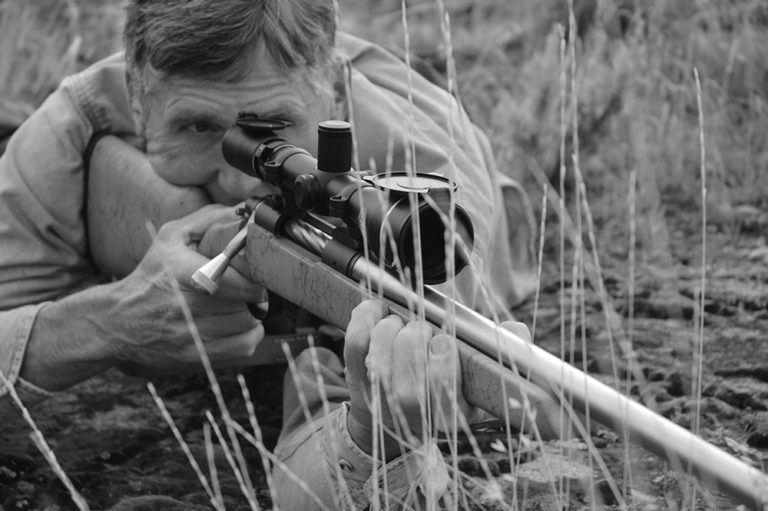

Riflemen crave more hits at greater distance. This hardware surely marches to that beat. Wayne van Zwoll provides long-range shooting tips on the rifles that really reach out there.
His group measured 14 inches by 36, less than a vertical minute of angle at 1,760 yards—a mile! But even 300-grain .338 match bullets drift in wind.
“Three feet. And it was a still day.”
Preston Pritchett began building rifles on his own actions five years ago, in his machine shop near Prague, Oklahoma. Disarmingly modest, he talks with a drawl, engages you with a boyish grin. Pritchett’s specialty is heavy rifles that shoot exceedingly well at long range. Testimonials abound, like this one from a Montana hunter:
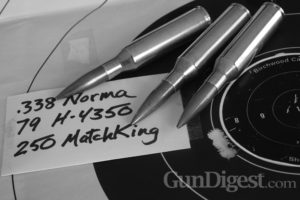
I’ve been running 155 [-grain] Scenars at 2,980 fps … with a 5-25X Schmidt & Bender PM2 … . I’ve taken 96 coyotes [16 at] over 500 meters. The longest shot [was] 1,120 meters.
That hunter also claimed a “five-shot group at 750 meters that went just under 2½ inches.” These days, high-velocity ammo and powerful optics encourage even casual riflemen to shoot far. F-Class competition for amateurs has joined traditional long-range events like the Palma Match. But what features enable rifles to hit reliably beyond normal hunting ranges? Say, 1,000 yards?
Pritchett shrugs. “A good barrel and a rigid action. We like Krieger barrels cut-rifled 1:11 for .308s, 1:9.35 for the .338 Lapua. We’re particular about crowns.” Short and long actions for Pritchett’s Surgeon rifles are built on site, with CNC tooling and an electrical discharge machine that holds tolerances to half a tenth. That’s half a ten-thousandth of an inch. Eight-inch receivers vary less than three-tenths, end to end.
A magnum receiver weighs 19½ pounds before milling.
“We cut all our actions from bar stock. We thread the barrel shank and mill the action face and lug abutments with the receiver secured in one fixture,” says Pritchett. “Surfaces stay square and true.”
Final machining follows heat-treating to 40 C Rockwell, to eliminate heat warp. Each bolt is machined from 4140 bar stock and tapers slightly to the front to limit play. Nitride treatment of bearing surfaces prevents galling. An Picatinny rail adds 20 minutes of elevation to the short-action, 30 minutes to the long-action. You can zero a Surgeon rifle at distance without running out of clicks or moving the erector tube far from the sight’s optical axis.
Short-action rifles wear the Remington extractor, long-action bolts a claw fitted inside the right-hand lug. “It throws the case out in a low arc to target knobs on scopes,” Pritchett uses Jewell and Remington triggers and McMillan stocks, pillar bedded. Charles Cowden of the Oklahoma Highway Patrol chose a Surgeon rifle with a Schmidt & Bender 5.5-20X Tactical scope on the agency’s sniper course. His groups measured “.2 minute at 400 yards, .4 minute at 500 yards, .3 minute at 600.”
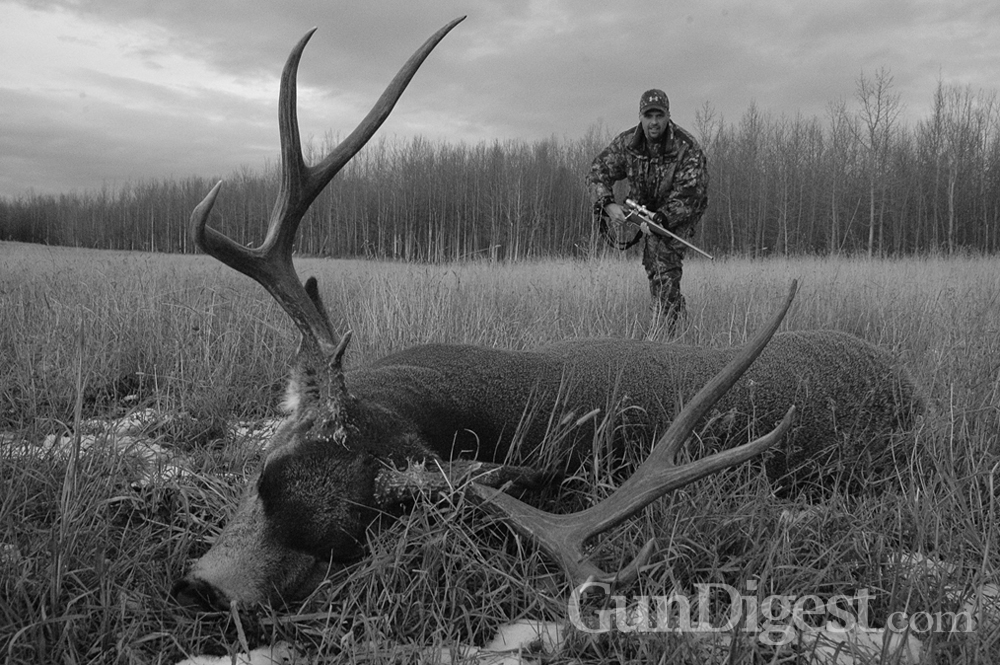
Accuracy from Alignment
All Preston Pritchett likes in a long-range rifle shows up in the long-action, 16-pound Remedy he loaned me. Equipped with a two-pound Jewell trigger and a 4.5-14X Leupold LRT scope, this .338 Lapua put my first three factory loaded Hornadys into a .2-inch hole.
“It’s just 100 yards,” shrugged Pritchett.
Indeed. But not all long-range rifles shoot that well up close. “Groups can improve as bullets go to sleep,” says D’Arcy Echols, who builds the most consistently accurate magnum hunting rifles I’ve seen.
In 1996, Echols was turning out four exquisite, walnut-stocked sporters a year from his Utah shop. To produce more affordable rifles, he committed to a mold for a high-end synthetic stock with classic lines.
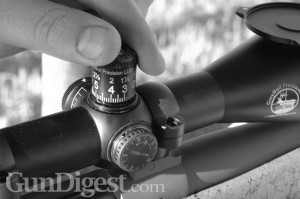
His Legend is a Winchester Model 70 with many refinements: re-machined receiver belly, bolt face, receiver face, recoil lug seats and lugs; lapped locking lugs; new pins in the trigger, ejector, and bolt stop to remove play; reconfigured ramp and rails; stainless five-round magazine box and follower engineered to the cartridge; custom bottom metal; steel scope rings machined to receiver contours and secured with five 8×40 screws.
Echols attributes the performance of his rifles to tight tolerances. “I surface-grind receivers on a mandrel between centers, so each is within half a thousandth of parallel with the bore.” A special gauge ensures perfect bore/chamber alignment. Most Legend rifles weigh around nine pounds with mid-weight, 26-inch Krieger barrels in .300 Weatherby, “though we’ve built some .300 Winchesters.”
Echols lets bullets coast just .125-inch before engaging the lands, a third of the start they’d get in Weatherby rifles. “The throat—that unrifled section of bore in front of the chamber—can be short or long, parallel or funnel-shaped,” he explains. “It allows the bullet shank to protrude from the case without engaging the rifling, and it gives the bullet a running start. Funnel-shaped throats, from blackpowder days, allow more bullet waggle than do parallel throats .0005-inch over bullet diameter.”
The funnel throat for the .300 Winchester Magnum is .3-inch at the rear of full-depth rifling, .315 at the case mouth. A parallel throat that allows the bullet to slide like a piston offers more guidance than does a tapered throat. But because bullet diameters vary, parallel throats must not be too tight.
The closer a bullet’s fit in the throat, the less critical is throat length.
“A long-throated rifle is said to have free-bore, but there’s no dimension that defines that, so the term is really meaningless,” D’Arcy says. “Besides, the most critical factor in accurate shooting at long range is the shooter.”
Texas gunmaker Charlie Sisk agrees.
“Most rifles shoot better than most shooters,” Sisk observes. “You can’t flinch. Also, the rifle must be held exactly the same every time. The striker sets up vibrations as it falls, before the bullet exits. Pressure from the rest and your hands affect those vibrations, as well as barrel alignment as it vibrates during bullet passage!”
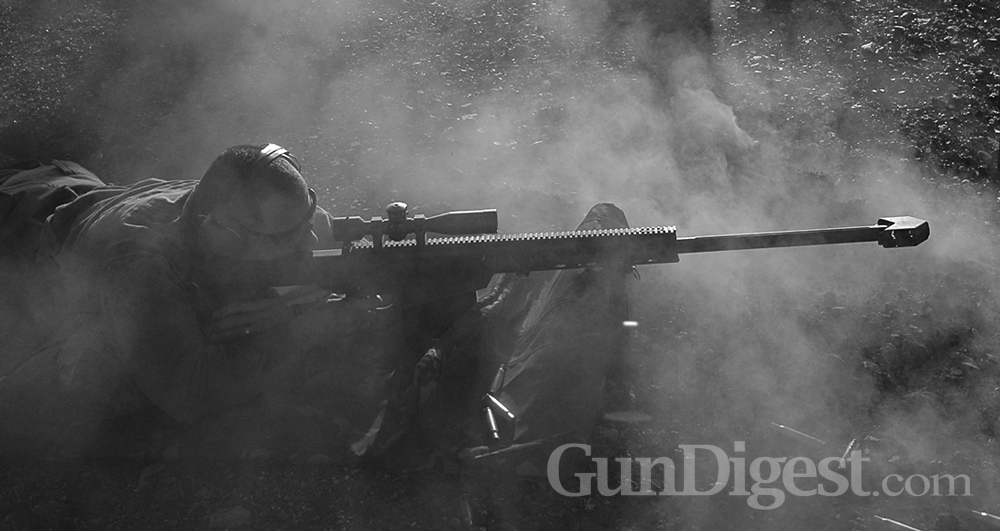
Among rifle components, Sisk says the barrel matters most. He told me, “I use Kriegers and Liljas. Others are good, too. It’s as important to have all components — barrel, receiver, mount, rings, scope — pointed at the same spot. That’s not as easy to achieve as it sounds. Few factory rifles have trued actions and perfectly aligned barrels with concentric chambers. Scopes and mounts lack the stress-free fit you need for accurate shooting at extreme range. Minor flaws in hardware that don’t show up at 100 yards become visible at 300, astounding at 1,000. Distance magnifies problems.”
Chamber dimensions affect accuracy. To accept all factory ammo, whose dimensions vary, and to allow easy loading under field conditions, chambers in hunting rifles are generous. Their dimensions also hinge on the reamer’s condition.
“A well-used reamer may produce a chamber .012-inch smaller in diameter than one cut with a new reamer,” says Charlie.
Because brass stretches, loose fit doesn’t matter to hunters. But, for tight groups at long range, you’ll want a snug chamber fit. Ammo matters, too.
“I spin bullets to sift out those with variations in jacket thickness,” says Sisk. “Once, after spinning, I measured groups from the best and worst lots. The most uniform bullets printed groups a third as big as the others.” He favors Berger bullets and Sierra MatchKings. “Concentric bullets at uniform velocities deliver the best accuracy. High ballistic coefficients minimize drift.”
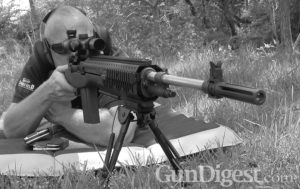
Sisk emphasizes that stiff barrels and actions deliver the best accuracy.
“Long barrels have more flex than short ones of the same diameter. That’s why some very accurate rifles have stubby barrels. I also like relatively sharp rifling twists. Heavy bullets spun fast may give mediocre performance at 100 or 200 yards; they take awhile to stabilize. But, at long range, they shoot flatter and with less wind deflection than light, quick-stepping bullets; groups, measured in minutes of angle, actually improve.”
I met Rick Freudenberg years ago on the Seattle waterfront, near where he builds target rifles that drill tiny groups. His own hunting-weight .30/284 shoots into half a minute.
“I like it because it delivers .30-06 velocity from a more efficient case.”
He’s built .308 rifles for Palma matches, using three-groove Lilja barrels with a 1:13 twist and a 155-grain Palma bullet in front of Varget powder. He also favors the 6.5-284 with Sierra’s 142-grain MatchKing.
“At 3,000 fps, both these loads shoot flat, with tolerable recoil.”
Freudenberg has also used muscle rounds like the .330 Dakota and .338 Lapua. A .300 Dakota on a Kelby action with a McMillan stock is “competitive at 600 to 1,000 yards with 190-grain MatchKings.”
For matches like the Palma, with its iron-sight stages, Freudenberg boosts sight radius with a 31-inch barrel.
“Irons or a scope,” he says, “you need a mirage band (an elastic strap from receiver to muzzle to keep heat waves from distorting the sight picture), for extended fire. I’ve also used a tube from a roll of Christmas wrap on my scope’s objective.”
Freudenberg says many shooters don’t get the reticles square with the action.
“Tilt the scope a bit or cant the rifle, and you won’t see much effect at 100 or 200 yards. But at 1,000, adjustments will move point of impact off-axis, and you won’t be able to shade reliably for wind.”
One thing these accomplished riflesmiths agree on: disciplined practice from field positions is the only way to ensure hits at distance. Holding the rifle still and releasing each shot cleanly will improve results more dramatically than can a rush to new hardware.

Next Step: Get your FREE Printable Target Pack
Enhance your shooting precision with our 62 MOA Targets, perfect for rifles and handguns. Crafted in collaboration with Storm Tactical for accuracy and versatility.
Subscribe to the Gun Digest email newsletter and get your downloadable target pack sent straight to your inbox. Stay updated with the latest firearms info in the industry.

![Best Concealed Carry Guns In 2025 [Field Tested] Wilson Combat EDC X9S 1](https://gundigest.com/wp-content/uploads/Wilson-Combat-EDC-X9S-1-324x160.jpg)


![Best 9mm Carbine: Affordable PCCs [Tested] Ruger Carbine Shooting](https://gundigest.com/wp-content/uploads/Ruger-Carbine-Shooting-100x70.jpg)
![Best AR-15: Top Options Available Today [Field Tested] Harrington and Richardson PSA XM177E2 feature](https://gundigest.com/wp-content/uploads/Harrington-and-Richardson-PSA-XM177E2-feature-100x70.jpg)

Easy as 1-2-3 on google search. https://www.surgeonrifles.com/
I’m very impressed with this article and the testemonials concerning the rifles that Preston Pritchett builds. I’d like to have the contact information on how to get in touch with him concerning having a rifle built. Where can he be contacted at, if you don’t mind.
L.C.